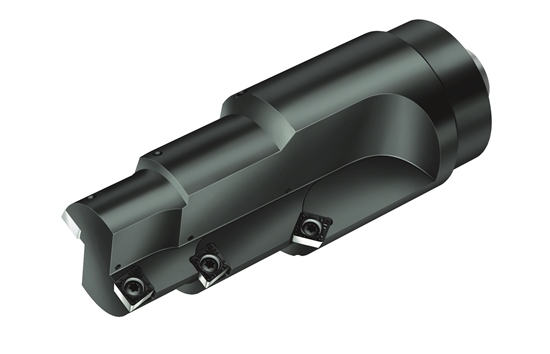
Toolmaker Walter USA LLC, Waukesha, Wis., has expanded its Walter Xpress line to include specials with the addition of indexable insert tools for drilling, boring and counterboring.
Using customer-specific parameters for drilling and boring applications, including diameter, number of steps (up to three), step lengths, chamfer angles, relevant cutting tool material options, insert shapes, machine features and cooling, the Walter configuration system designs the required tool and generates comprehensive documentation, including a 3D model. The customer receives a quote within 24 hours, while the bill of materials, work schedule and NC manufacturing programs are created to begin manufacturing the tool to begin production once the order is placed, according to Walter.
The resulting delivery time once an order is placed is 3 weeks, in contrast to the industry standard of 1 to 2 weeks for quotations alone, with tool production taking between 6 and 8 weeks. In addition to the shorter turnaround, the documentation generated by Walter Xpress allows customers to begin using the tool immediately upon receiving it.
Walter Xpress specials for drilling applications are based on Xtra-tec point drills for the diameter range of 0.047" to 1.26" (12 to 32 mm), and Xtra-tec insert drills in the range of 0.65" to 2.32" (16.5 to 59 mm). Solutions for boring and counterboring can be supplied with fixed insert seats or cartridges and have a diameter range of 0.64" to 7.87" (16.5 to 200 mm). There are different cartridge options and all tools can be designed up to drilling depths of five times diameter. The available ISO insert shapes are C, S, M and T and all popular spindles are offered: Parallel shank, HSK, SK, NCT, Capto, Catshank and ScrewFit.
Related Glossary Terms
- boring
boring
Enlarging a hole that already has been drilled or cored. Generally, it is an operation of truing the previously drilled hole with a single-point, lathe-type tool. Boring is essentially internal turning, in that usually a single-point cutting tool forms the internal shape. Some tools are available with two cutting edges to balance cutting forces.
- counterboring
counterboring
Enlarging one end of a drilled hole. The enlarged hole, which is concentric with the original hole, is flat on the bottom. Counterboring is used primarily to set bolt heads and nuts below the workpiece surface.
- indexable insert
indexable insert
Replaceable tool that clamps into a tool body, drill, mill or other cutter body designed to accommodate inserts. Most inserts are made of cemented carbide. Often they are coated with a hard material. Other insert materials are ceramic, cermet, polycrystalline cubic boron nitride and polycrystalline diamond. The insert is used until dull, then indexed, or turned, to expose a fresh cutting edge. When the entire insert is dull, it is usually discarded. Some inserts can be resharpened.
- numerical control ( NC)
numerical control ( NC)
Any controlled equipment that allows an operator to program its movement by entering a series of coded numbers and symbols. See CNC, computer numerical control; DNC, direct numerical control.
- parallel
parallel
Strip or block of precision-ground stock used to elevate a workpiece, while keeping it parallel to the worktable, to prevent cutter/table contact.
- shank
shank
Main body of a tool; the portion of a drill or similar end-held tool that fits into a collet, chuck or similar mounting device.






